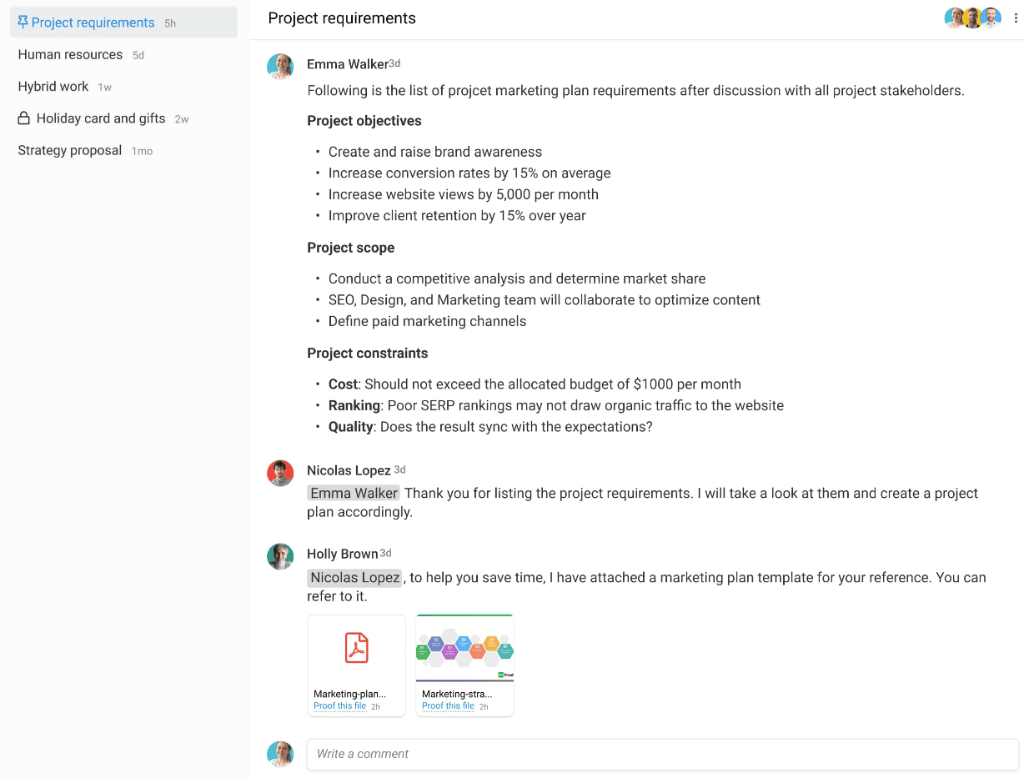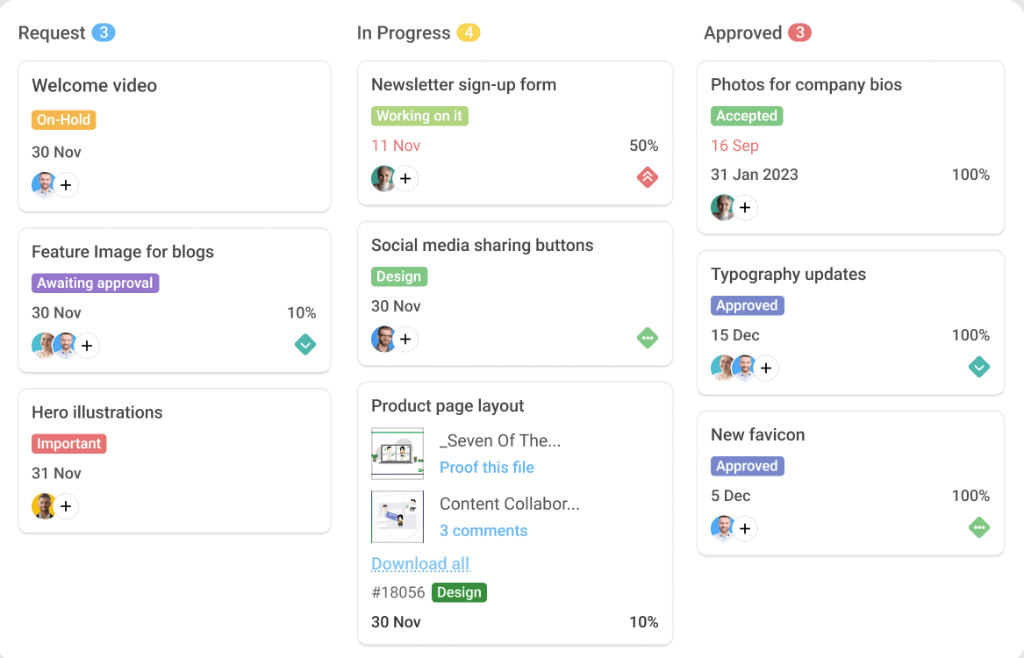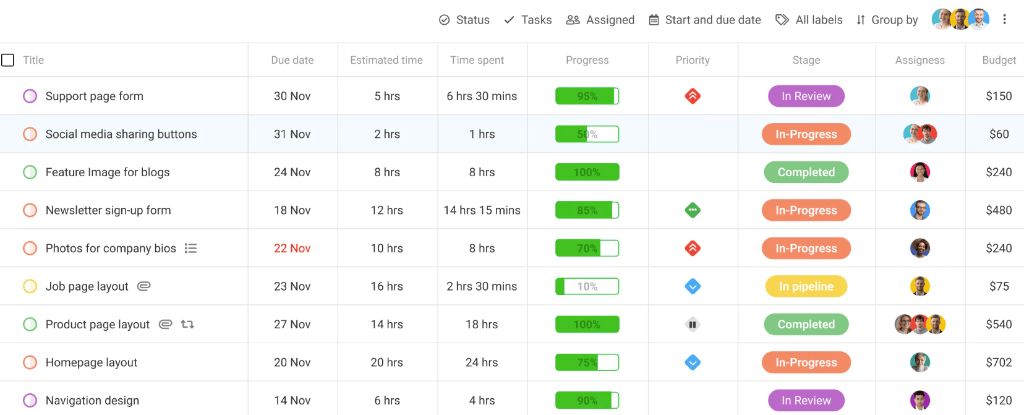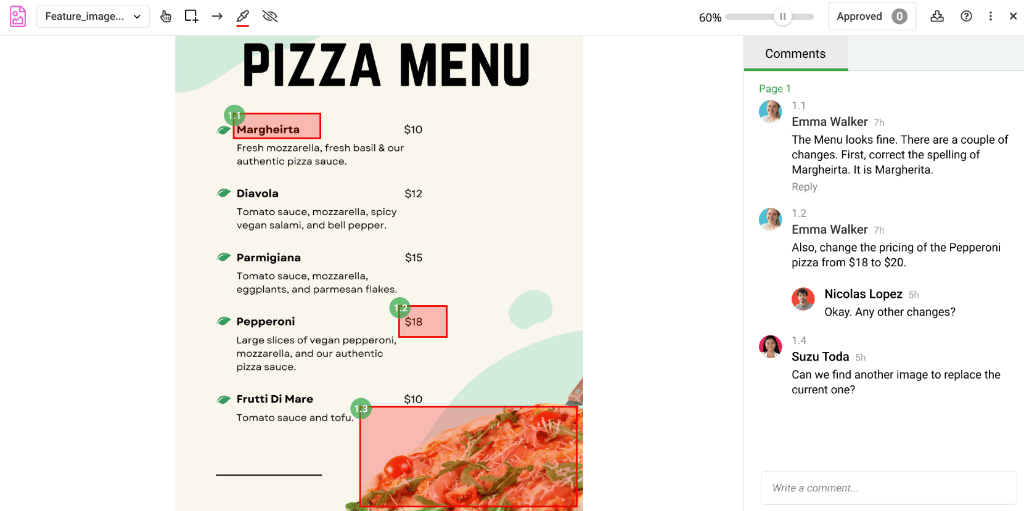After having thoughtful communication strategies and implementing effective internal communication methods, are you still not in sync with your team?
Do you know why?
I can understand the situation, when you start bringing about a change in your organization, even in a positive way, it’s difficult to implement that at the initial stage.
The reason is very simple. Employees mold themselves into a pattern, and when this pattern gets disturbed, it’s difficult for them to start from the beginning to adjust.
This is just one reason; there are certainly other factors that we miss or think are not important to consider in implementing internal communication at work. To foster internal communication, there is no ‘one size fits all’ approach.
To overcome such issues and improve internal communication in the workplace effectively, practical solutions must be implemented. Prior to that, let’s understand what exactly is meant by “effective internal communication” and why it is necessary.
Discover 7 employee communication softwares that can help you boost both engagement and productivity levels in your workplace!
Table of Contents
- What is effective internal communication?
- Why is it important to improve internal communication?
- Top 11 ways to improve internal communication in the workplace
- 1. Establishing clear communication goals
- 2. Check in with your employees
- 3. Foster a culture of open communication
- 4. Use an anonymous “suggestion box”
- 5. Choose appropriate communication channels
- 6. Encourage people to work via their preferred platform only
- 7. Prioritize team-building activities
- 8. Encourage face-to-face communication
- 9. Promote employee recognition
- 10. Convey authenticity
- 11. Constantly monitor and evaluate your efforts
- Examples of Effective Internal Communication
- How ProofHub Helps Improve Internal Communication in Workplace
- ProofHub roles in improving internal communication:
- Final words
- FAQs:
What is effective internal communication?
Effective internal communication occurs when there is a seamless flow of information within the organization. Simply put, when there is a good understanding of company goals, no information silos within departments, and employees are well connected with their leaders, your organization has streamlined internal communication.
Even many studies and researches have emphasized that proper information flow in an organization is important.
According to one study done with the millennial generation, “companies should eliminate the barriers that come in the way of internal information flow and deliver regular feedback to employees if they want to effectively engage employees.”
Don’t ever think twice about practising to improve internal communication. Just remind yourself once again and be ready to make the required changes.
Why is it important to improve internal communication?
According to a study conducted by Fierce, Inc., “86% of employees blame inefficient communications for workplace failures.”
Organizational culture and performance depend on the effective communication and collaboration of the employees. The better the internal communication, the more the team can understand which direction to work in.
Internal communication helps to
- Strengthens team relationships and organizational culture.
- Build trust and improve employee engagement.
- Greater job satisfaction with high morale to do work.
- Better teamwork and intra-departmental collaboration.
- Improved job retention rates and better organizational outputs.
This all together strengthens the change management. The goal of change management is to develop strategies to bring about transitions in organizational goals, work structures, or processes for the betterment of the company.
Therefore, don’t lose hope if you are trying but are not able to foster internal communication. Because every effort of yours is worth a better organizational culture and work life.
I have learned through my experience that every bit of missed detail is important to foster effective internal communication. These are some of the ways that I used to improve internal communications. Let’s give a read:
Top 11 ways to improve internal communication in the workplace
“How to improve internal communication at work” is sometimes complicated. Whether the communication gaps are from the top management or within departments, both are problematic. Also, when you choose a communication tool and a particular communication style to start with, how to get people along with you also sometimes becomes a task. So, lets collab everything and discuss where the problem is:
Let’s take a look at how to improve internal communication at work:
1. Establishing clear communication goals
You start working on an internal communication strategy, but do you know exactly how you want to communicate and collaborate?
Are your team members aware of the company’s mission and vision?
Do your employees know about your communication plans?
These questions are important to give your employees a clear idea of what your company does and how they can contribute. Only then can they better connect and collaborate with you and their team.
As a leader or manager, it’s your duty to ensure that your team is aware of the goals and associated expectations.
Whenever a new project is started, I always adhere to a planned procedure to generate a clear communication goal for my team:
- “Define the key objective” and efficiently explain this to your team.
- “Develop a plan,” i.e., establishing an effective communication planning with defined stages, deadlines, resources, and responsibilities required to complete the plan.
- Afterwards, “communicate the plan” with your team and ensure that everyone understands their part in attaining the goals.
- “Encourage them” to discuss and share their doubts or ideas about it.
- “Set expectations” in terms of job quality, timelines, and any other pertinent information.
I definitely get results working on this strategy; you can also give it a go and try it with your team.
2. Check in with your employees
Another effective approach that must be considered while fostering effective internal communication is to “check in with your employees.” This approach will help you to:
- Understand your team’s thoughts and feelings.
- Valuable insights and feedback from your team on your strategy.
- Places where your communication strategy is lacking.
- Increase the team’s performance and morale.
To make the most of my check-ins, I consider the following tips:
- Conduct regular check-ins, for instance, once a week or twice a month.
- Promote open-ended discussions in the meeting.
- Make notes of important feedback and then follow up on it regularly.
3. Foster a culture of open communication
Not having an open and direct conversation with a team can actually have an unwanted impact on your organizational culture.
- Low morale
- Negative feedback
- No enthusiasm to do work
- Conflicts and misunderstandings about roles and responsibilities
If “open communication” is a part of your internal strategy, then implement it immediately.
- Tell your employees that “you are available for them.”
- Do “Sessions”
- Listen “to their problems.
- Always initiate; don’t wait for employees to come and talk. Be responsive and take action.
4. Use an anonymous “suggestion box”
“Suggestion Box” for employee communication, queries and feedback. Might sound old-school or frivolous!
But this can actually be very helpful.
There are team members who are not always comfortable voicing their issues openly, which is why an anonymous approach may be just what is needed to enable honest and open feedback.
You only need a box, a pad of paper, and a pen.
You can, of course, direct your team to a virtual version that serves the same purpose.
5. Choose appropriate communication channels
Sometimes we only go with the flow and popularity. In the midst of this, we forget the actual purpose of what we are looking for: an internal communication channel.
You need to be very clear about the purpose for which you are searching for the tool.
- Whether it is for formal or informal communication
- Is this for a team or for the whole organization?
- Is this just for conversation or also for project discussions, file sharing, and project management?
- Also, how will your selection of a tool impact your company’s culture?
These are some of the questions that you need to answer and then go through a proper channel. Find out if you need only a messaging app like Slack, a video conferencing tool like Zoom, or a single platform like ProofHub where you can manage your work and communicate at the same time.
Get everyone in the loop with the top 18 team communication tools tailored to meet your business needs and goals.
6. Encourage people to work via their preferred platform only
You have selected an appropriate communication channel for yourself.
Now, what would be your next step? How you will encourage them to use those
- “Lead by example“, When you start using the platform for every single conversation and work for what you have chosen for the tool, your team will also follow suit.
- “Feedback sessions on the tool“: you chose a communication tool, so don’t retrain yourself from sharing feedback and doing discussions on the app. Set aside a day a week to do such things. It will help you form the habit of using that platform.
- You should “give training” to both new joiners (during onboarding) and present employees to increase their knowledge about the tool.
Try to follow these points and see the change. Your team will be more habitual about using the channel, which will help you come one step closer to the working environment with effective internal communication.
7. Prioritize team-building activities
Because sometimes leaders get bogged down with day-to-day tasks and goals, they fail to work on their communication with their team.
Investing in your employees as people will improve your professional relationship with them in the long run. And you can do this by holding weekly or monthly team-building activities.
The best 3 team-building communication activities are:
- Just listen
Create a few discussion subjects; try to stay away from anything too controversial, but you could choose something that has been a problem in the past. Pair up the group members, designating one as the speaker and the other as the listener.
- Acting emotions
This is the most effective method for learning about nonverbal communication. Make a deck of cards, each with a different emotion printed on it.
Give one employee a card and instruct them to play out the feeling. The other workers must estimate the emotion.
Hold a dialogue once everyone has acted out at least one emotion. Discuss which emotions were easiest to represent and guess. What could be the reason behind this? Then, go over the instances in which facial expressions are crucial at work.
- Blindfolded activity
Trust is a key part of communication. There is no better way for employees to learn to trust their peers than to blindfold them!
Make an obstacle course out of regular office things in a moderately sized space.
One employee should be blindfolded, while another should lead the first through the obstacle course. Repeat to give everyone on your squad an opportunity to try.
Those who use clear and precise language will be the most successful at leading. Use this as a teaching point at the end of the session to discuss why it’s crucial to use as few words as possible while explaining to avoid confusion.
Read More- Team Building Activities to Develop Positivity at Workplace
8. Encourage face-to-face communication
Face-to-face contact is often seen as superior to other modes of communication because it provides a more exclusive and authentic experience.
It enables humans to understand nonverbal signs like facial expressions, gestures, and tone of voice. This basically helps to generate better connections and relationships by providing a more personal and authentic experience.
Using this mode of communication, you can better connect with your employees internally and also guide them on how to use internal communication strategies more effectively. Try to
- Conduct regular meetings
Regular team meetings are a great way to address key issues, brainstorm ideas, and establish relationships. Establish a regular meeting calendar and ensure that everyone is aware of when and where the meetings will take place.
- Build shared spaces
Create shared office places for team members to gather and connect, such as a break room, lunch area, or shared workspace. These areas can promote casual discussion and the development of relationships.
- Set an example for your team
Practice good face-to-face communication as a leader or manager by being approachable, courteous, and open to feedback. This can help set the tone for positive workplace communication.
9. Promote employee recognition
Even a little appreciation and recognition for what the team has done helps to improve their morale and engagement.
Without a recognition program, it’s difficult to keep their work enthusiasm alive as your employees not only work to earn but also to gain more knowledge and do better in their field. Recognition is one thing that helps them know they are going in the right direction.
So, how should you promote employee recognition?
- “Say thank you” and “appreciate their “Say thank you” and “appreciate their efforts” every time your team finishes a project before a deadline.
- “Celebrate milestones” by congratulating your team on their anniversaries, hard work, and individual achievements as well.
- “Wall of frame” is also a great way to recognize employees who give years of their experience to the company.
Check out these 13 widely-used employee recognition software options across the globe and start giving your team the recognition they deserve!
10. Convey authenticity
According to the “Edelman Trust Barometer 2019 annual report,” trust is critical to developing a loyal and engaged workforce.
It is my personal experience that when employees are dedicated to the organization they work for, productivity rises and turnover falls.
So, how does trust build? Definitely by being authentic to your team.
How can you communicate with authenticity?
- “Share your story” means telling your struggles, efforts, and how work helps your employees get to know you better and be the same.
- “Tell the truth,” because no matter what the problem is, keeping workplace transparency helps employees be more attached and develop trust.
- “Empathize with your team.” Understanding and empathizing with the feelings of individuals around you fosters connection and improves your ability to communicate effectively.
11. Constantly monitor and evaluate your efforts
Constantly monitoring efforts to enhance internal communication is critical because breakdowns in communication can emerge without regular check-ins and assessments, leading to misunderstandings, lost productivity, and even conflict.
Companies may verify that they are fulfilling their communication goals and making the required adjustments to improve their operations by reviewing and tracking these efforts.
You can examine and track their efforts to improve internal communication by:
- Conduct employee surveys and feedback sessions to know what your team thinks and suggests.
- Use the communication channels properly and keep evaluating whether they are serving their purpose or not.
- Hold regular team meetings or check-ins with individuals to discuss any communication issues or concerns.
- Set specific communication goals and track progress toward them on a regular basis.
So, these are the 11 ways that I always keep in check that actually help me to better build an internal communication strategy and implement it with the team. You know the tips, but are you aware of which internal communication examples are best to maintain smooth and uninterrupted team communication?
Examples of Effective Internal Communication
Talking about examples, these are actually communication methods. Some of these methods you may be familiar with, while others you may not have considered as internal communications channels. Let’s take a look at these:
1. Open-door policy
You just can’t deny the communication benefits of open-door policy. This is a good example of communication because it helps to encourage transparency.
Good managers recognize that their teams are not robots and that they may require a sympathetic ear and assurance that they will listen if they find themselves in difficult situations.
To foster an open-door policy:
- Encourage open and honest communication within the team.
- Listen actively and share feedback.
- Make oneself approachable and available.
- Maintain confidentiality and respect the privacy of your personnel.
- Take the necessary action in response to the issues raised.
2. Effective onboarding processes
Effective onboarding practices are critical for establishing expectations, setting the tone for clear and consistent communication, and fostering a healthy connection between the business and the new employee.
To improve the onboarding process:
- Set specific objectives and standards for the onboarding program.
- Ensure that the procedure is consistent and adapted to the needs of each employee.
- Assign a mentor or companion to help the new employee get started.
- Use technology to simplify the process and make information more accessible.
- Check-in with the new employee to confirm that their integration is going well.
3. Videos
Do you know how videos can improve the engagement of your employees in newsletters and other company-related updates? If you rely on long email forms to include this information, you risk losing the information and employee engagement before they can grasp the message. Videos are helpful to get better employee attention, convey the right message, and are more memorable than a simple, lengthy text format.
Keep these things in mind to send a clear message via videos:
- Use a conversational and engaging tone.
- Keep your videos short and to the point.
- Use pictures and graphics to enhance the message.
- Make the videos available on a range of devices to guarantee that all employees have access to the content.
4. Internal sharing platform
An internal sharing platform can be an excellent example of workplace communication because it allows employees to easily communicate and collaborate.
Internal sharing systems aim to break down silos and increase overall interaction within organizations by providing a single platform for exchanging documents, messages, and information. They also make it easier for remote teams to collaborate and stay connected, regardless of where they are.
When talking about an internal sharing platform, it is essential to evaluate the organization’s particular goals and how the platform might be adjusted to fulfill those goals. Once you’ve cleared up the ambiguity, a great communication platform is your best bet for fostering internal communication.
In this context, ProofHub is the best fit as an internal sharing platform because it provides a centralized space for team members to collaborate, exchange ideas, and communicate in real time, increasing productivity and decreasing email clutter. Let’s take a look in a little detail at how choosing ProofHub would be a great deal for your organization:
How ProofHub Helps Improve Internal Communication in Workplace

ProofHub allows you to remain in touch with your team members, provide timely feedback, and handle issues swiftly. This leads to enhanced teamwork, increased productivity, and better project outcomes. Furthermore, being on a centralized communication platform, it helps to save time and keeps you organized, which is vital when handling many tasks at the same time. ProofHub can help you become more productive and efficient at your work.
ProofHub roles in improving internal communication:
- Connect with your team in no time
With ProofHub, it is very easy to keep your team in the loop. You can give real-time feedback, convey updates, do one-on-one conversations and discuss projects with your team. There is no need to use multiple apps or go forth to send information.

- Keep everyone is on the same page
Using customized workflows, managers and leaders may tailor the workflow of their teams’ as per their needs and expectations, ensuring that everyone is on the same page and projects are finished effectively.

- Get a clear picture of work
With ProofHub, it is simple to assign, create and prioritize tasks, create deadlines, and track progress. You can obtain a complete picture of your team’s workload, ensuring that they are working without stress and effectively, without any hurdles.

- Instantly collaborate for better results
You can quickly work on documents and other creatives with your team in real-time by using ProofHub’s proofing and review feature. Give comments and make modifications as needed, ensuring that projects are performed accurately and effectively.

- Maximize your time utilization efforts
Track your and your team’s time spent on tasks and projects to gain useful insights on the team’s productivity and workload. Use those insights to find areas for development and improve the employee performance.

Streamline team communication, eliminate silos, and always deliver the right information with ProofHub. Benefit from our no-cost sign up offer now.
Final words
Noticing and keeping small things in mind will help you effectively improve internal communication in the workplace. The above-mentioned thing might look very minute but is important for employee morale and engagement. With ProofHub, you can not only better connect with your team but also communicate seamlessly within seconds in real-time whenever you need to.
FAQs:
What is the aim of internal communication?
The aim of internal communication is to provide an efficient flow of information within a company. It fosters a secure, supportive environment in which people are encouraged to voice their thoughts.
What makes effective internal communication?
Internal communication is effective when information flows freely because teams are then better able to comprehend the objective and work. Communication tools like ProofHub play a big part in this.
Why improve internal communication?
Internal communication is a significant strategy to involve employees, teams and enhance workplace communication while also making yourself more approachable.
What makes internal communication successful?
A combination of good information flow, two-way feedback and use of good internal communication methods make internal communication effective.
How do you streamline internal communication?
Using a common platform, establishing clear communication norms, prioritizing openness, encouraging feedback, and offering training on effective communication are all ways to expedite internal communication.
What are 3 methods of internal communication used in an organization?
Stand-up meetings shared project management platforms and video conferencing tools are three common methods of internal communication, allow efficient and timely communication between the teams.
